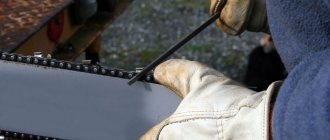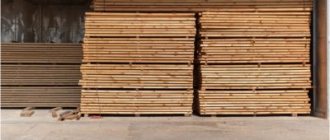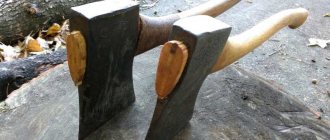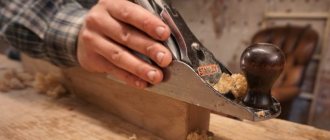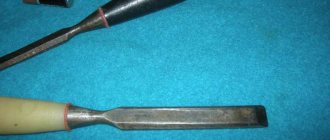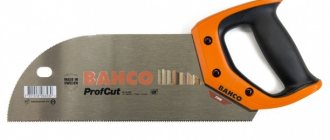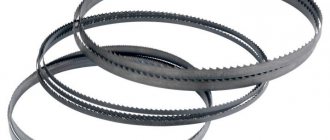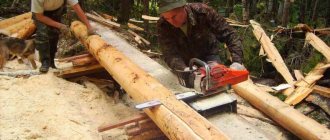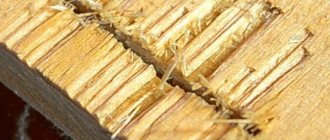The use of even a branded surface planer, produced using advanced technologies, requires periodic updating of some of its parts. The knives of this equipment must always be kept perfectly sharp, because the longer you do not correct the situation, the more difficult it will be to return the blades to their original sharpness.
Tool sharpening prices
Knives for thicknessers and jointers can be sharpened many times; I remove the minimum required layer of metal using the correct sharpening equipment.
| Video examples of our work on sharpening knives for surface planers and other tools |
Sharpening thicknesser knives in our sharpening studio costs 150 - 300 rubles.
We sharpen nail scissors and tools, knives, including ceramic ones.
Sharpening of knives for planes and surface planers is carried out using professional equipment
Our workshop is located 200 meters from Taganskaya metro station.
We are open 7 days a week from 10:00 to 20:00
| Courier delivery in Moscow is at your service from Monday to Friday |
| Depending on the specifics of the product being manufactured, the sharpening angle of the thicknesser knife may vary. An incorrectly selected sharpening angle can cause the blade to quickly become dull. | |
Sharpening of thicknesser knives, which our company offers, will allow your equipment to work at an impeccable level, just like right after purchase. Our service specialists use special tools in combination with innovative sharpening techniques. It is impossible to achieve the razor-sharp knife blades that you get after contacting our company on your own at home.
Tool sharpening
Sharpening jointer blades is a simple process, you just need to move the holder from side to side relative to the whetstone. Try not to let the blade go beyond the edges of the stone. Fix the holder 12 mm from the end of the circle. When carrying out work, it is necessary to establish a supply of water cooling. Be prepared to regularly replenish the fluid in the tank and not allow the tank to dry out. To ensure safe work, you need to ensure that moisture does not flow onto the floor under your feet.
Sharpening jointing knives is a rather lengthy procedure. Periodically check the cleanliness of the whetstone, as it can quickly become dirty. To clean it, you need to use a special bar as soon as contamination is detected. By the way, the choice of stone largely depends on the type of instrument. A planer can include knives of varying hardness types, so choose your whetstone carefully.
Typically, jointer knives are sharpened for 20 minutes, after which finishing needs to be done. This procedure is carried out using a special paste. Polishing is carried out so that the blade does not have the slightest roughness or burrs, otherwise the work with such a knife will not be complete. Check the effectiveness of sharpening by cutting a piece of paper with it. If the cut is made carefully, then the knife is completely ready for use.
Other materials for sharpening tools: * Sharpening a hacksaw for wood. * Sharpening a chisel with your own hands.
Subscribe to our Yandex.Zen channel
High-quality sharpening of planing knives
To work accurately and accurately with cutting tools, it is necessary to monitor their condition and periodically sharpen them. The working tool can be made even sharper by entrusting it to our experienced craftsmen. All of our employees are specialists with many years of experience, and they operate special machines perfectly. Without a doubt , sharpening thicknesser knives and sharpening flat knives of any type is exactly the service that we provide better than all competitors on the market.
| Our craftsmen will not only carry out high-quality sharpening of reismx knives, but will also remove chips, if any, which is especially important for precision tool knives |
Sharpening process and operating rules
Scheme of a machine for sharpening knives.
The holder moves to the right and left, movements are made relative to the sharpening stone. The blade should not be allowed to go beyond the edge. It is best to immediately install the holder 12 mm from the edge of the working circle. If sharpening is carried out, water cooling must be supplied. You will have to add water to the tank, you need to make sure that it does not run out. It is necessary to ensure that water does not accumulate on the floor near your feet. This is done for security reasons.
When performing work, you must ensure that the stone remains clean at all times, as it gets dirty quite quickly. A special whetstone is used for cleaning; it is recommended to carry out this procedure frequently, since only clean stones can be used for sharpening. The choice of stone itself depends on what kind of knives are used. Today, manufacturers produce jointing knives from soft or hard tool steel, so working conditions will vary.
Sharpening takes approximately 20 minutes, then fine-tuning is done. A special paste is used for this. After polishing, there should be no burrs left on the surface, otherwise the jointing knife will not be ready for use. The test is simple to carry out; a finished knife with excellent sharpening should easily and evenly cut a sheet of paper while hanging, leaving a neat cut.
How sharpening happens
Sharpening thicknesser knives is quite simple:
- The blades are fixed in the bar.
- The block is placed on the sandpaper and moved up and down (progressively).
Source youtube.com
The process is quite long, but controlled, since you will not damage the knives.
You can see how blades for a thickness planer are sharpened in the video:
Preparatory work
Anyone who has a plane or jointer faces the problem of sharpening knives. It is expensive to constantly buy new ones, especially since knives can be easily sharpened with your own hands using special machines or sharpening stones. If the jointer is used frequently, like other woodworking equipment, then it will be inconvenient to constantly send knives to the workshop for sharpening. It is better to assemble the machine yourself. To ensure that the jointer is always in working order, it is recommended to sharpen it at home. The easiest way to do this is with a regular sharpener. You only need to take a sharpener with low speed, its quality should be high. Water cooling must be available.
Scheme of the sharpening angle of a jointer knife.
You can also use a sharpening stone, but it must first be leveled with a special device. Usually it comes complete with a small sharpening machine, so there is no need to additionally look for such devices. After the editing is completed, it is necessary to smooth the stone; a block is used for this. Sharpening a jointer knife without this step will be problematic.
What to do next? You need to set the angle of inclination. A special screw will allow you to correctly secure the blade relative to the position of the sharpening stone. Using this screw, you can subsequently set any angle of inclination of the knife. Next, take the holder that comes with the machine. A jointing knife is installed in it. Experts advise starting sharpening knives whose width is at least 13 mm . The length is not critical; if necessary, the knife holder can be rearranged to any position.
The knife must be securely fastened in the holder, otherwise sharpening will be carried out skewed, and this will worsen the quality of the jointer. How to properly secure a knife in a holder? While holding the blade in the desired position, tighten the clamping screws until they stop. To control the sharpening angle, you must use a marker; it marks the sharpened chamfer of the knife. It is with this simple method that you can easily monitor the quality and progress of work. The sharpening will be correct if the corner of the knife touches the stone. The stone must be rotated manually to determine if further adjustment is necessary.
Sharpening angle of knives for planing machines
Any owner of planing equipment has had to deal with sharpening the corresponding knives. If you have a special machine at your disposal, then this will not be difficult to do. Another option would be to contact a specialized workshop. You can also sharpen such cutting tools yourself.
Why is timely and correct sharpening necessary?
Planing knives, like other cutting tools, require maintenance for certain reasons:
- with a blunt blade of planing knives, the wood will be processed very poorly;
- when working with soft types of wood, pile and various irregularities will form on the surface;
- the worn edge will crumble;
- When planing with blunt tools, the machine motor overloads
Even if you decide to sharpen it yourself using diamond stones, the effect of such work will be very insignificant. You'll have to resharpen them soon. For these reasons, people who plan professionally choose only automatic or mechanical sharpening.
Preparing the workplace and equipment, installing the screw that controls the angle
To sharpen knives, you will need a special sharpener, but you must use modern variations of it with a low speed, which have water-type cooling. The Tormek T7 with a special Tormek SVH holder is most suitable for these purposes. A smooth and clean sharpening stone will help you complete this process efficiently. In the future, a practical example will be considered based on a set of Tormek equipment.
When sharpening, you need to install a screw with which you can change the sharpening angle, but first you need to prepare the workspace by fulfilling certain conditions:
- We install the Tormek SG250 sharpening stone, leveling it using a special tool Tormek TT-50. The device comes complete with T7.
- It is necessary to smooth the sharpening stone using a cleaning and leveling stone.
- We remove the standard stop and install a specialized stop.
- We screw in the screw itself, which can later be used to adjust the angle of the chair being sharpened.
- We install a special holder for the blade.
It is recommended to sharpen cutting tools whose width is more than 12 millimeters. And the length of the knife no longer matters. In addition, you can rearrange long knives. Correct installation of the blade in the holder is of great importance, because sharpening with large distortions is possible. Correctly this process is performed as follows: install the back of the knife all the way and clamp it with special holders.
Estimating and setting the required inclination angle
By analyzing the characteristics of the marks left by the sharpening stone, it is possible to correctly assess the angle of inclination by selecting the desired proportions. Then a holder with a knife is installed on the fixed stop. Adjustment is carried out using the stop screws; you need to lower the holder until it touches the stone. Using the angle adjustment screws, select the required parameter in relation to the stone. When rotating manually, the marks on the painted blade determine the need to adjust the angle of the holder. And if necessary, such adjustments are very easy to make.
Operating angle range 30-45 degrees. Its exact degree is determined by the specific type of tree. A 1985 handbook written by Karl Fronius states that quality will depend not only on the angle, but also on the blade's reach and head diameter. The classic parameter is considered to be 40 degrees. When choosing a specific number, do not forget that the cutters are designed according to a standard backing. If you increase the angle, there is a risk of the butt rubbing against the workpiece. And if you reduce it, the cutting edge will become weaker and thinner.
Solving the problem of choosing the right angle
There are two ways to solve the problem of setting the required angle of inclination:
- Using a double-headed backing based on the principle of double-layer blades. We make the main back at an angle of 40 degrees, and the very top of the knife - about 20 degrees. This will significantly extend its service life, and the knife will also have good shock resistance.
- Check the sharpening pattern and modes.
Some rules and features of sharpening
Having set the angle of inclination to the desired position, you can begin the sharpening process itself. You can record the amount of metal being removed; two sliders with a scale and 0.1 mm division are designed for this purpose. The sharpening specialist will be able to adjust this parameter quite accurately. Do not forget to securely fix it with special clamps after each filing to prevent vibrations during sharpening.
The sharpening process itself is carried out by changing the position of the holder in relation to the sharpening stone. It is important to ensure that the knife does not go beyond the extreme point of the stone. It is advisable to stop the holder 10 mm from the edge. Separate stops are provided as a braking element, by moving which the desired stroke is set. The decisive factor here will be the experience of the person who sharpens the planing knives. During the process itself, water is formed, which accumulates and collects on the blade. Then it flows onto the body itself and onto the floor. A lot of water is wasted, so don’t forget to constantly add it to the special section. And the spill itself can be reduced by placing some kind of pad under the leg, 6 mm high.
Another nuisance during sharpening will be the constant clogging of the sharpening stone, which affects the duration of this work. It is best to periodically clean it with the SP-650 bar provided for this purpose. When working with soft metal, sharpening will go much faster and the stone will have to be cleaned less often, because such material is removed in fairly massive sections.
After half an hour of work, you get an even chamfer with a stable burr. All that remains is to polish it using a leather wheel and polishing paste. First of all, you will need to complete the plane of the knife, and only then the chamfer itself.
Features of working with a manual machine
Manual machines are used only in cases where it is necessary to sharpen not too many knives. Otherwise it would have taken a lot of time. But if you need to sharpen several knives, then this method will be quite acceptable, but you must adhere to the following rules:
- you need to check the surface of the stone, because the use of such machines is only possible with clean sharpening tools;
- try to make sure that the carriage with the attached knife is brought in quite smoothly, without any sharp jolts;
- the speed of movement of the carriage should not exceed 6m/min, high speed may damage the blade;
- During one pass, the carriage must advance a distance that is 15 cm greater than the length of the knife.
Features of working with an automatic machine
- the wet method is more suitable for sharpening planing knives, because the blade is constantly cooled;
- at the preparation stage, you already need to set all the parameters, including the angle of inclination and the distance of movement of the carriage;
- the most important factor is the installation of knives on the carriage;
- the process should be carried out quite smoothly, without sudden twitching
DIY sharpening machine
If desired, it is possible to assemble the sharpening machine yourself. You will need the following items: table, faceplate, vacuum cleaner, motor and machine cover. The faceplate will become the main and most expensive component. It is advisable to choose American or German manufacturers. Then an engine with a power of 1.5 kW is selected; even supported options are suitable. For example, you can purchase motors from washing machines.
The motor must be installed under the tabletop, and the faceplate must be secured to the moving element. Don't forget to consider the on and off buttons. You need to put a casing on the faceplate, cutting off one side, from which sharpening will be done. You will also need to make a cutout at the bottom of the tabletop for a vacuum cleaner. This machine is also suitable for working with other cutting surfaces.
Sharpening knives in specialized workshops
If you are unable to organize the correct sharpening of planing knives or it becomes difficult to set the desired level of inclination, then contacting a workshop will be an excellent solution to the problem. This method has the following advantages.
- Expensive and high quality equipment is used. The straightness of the cutting edge will be much better than when processing it yourself.
- Modern cooling systems are used that will prevent the cutting surface from overheating and collapsing.
- Additional materials and special technologies are used to refine the knife, which affects the functionality and service life of such knives.
- In a workshop environment, it is possible to obtain the most even edge due to the absence of overheating and weight differences. In practice, the result should be an ideal instrument.
Problems and preparation
First, I dismantled the knives to understand their condition. The middle was completely erased, the gap was visible to the naked eye. Then I was faced with a choice: sharpen or buy new ones.
I had to research the issue myself. New ones turned out to be difficult to find and they are expensive. Sharpening is an even more difficult option. I contacted one office, where they told me that they could only sharpen small blades (up to 300 mm in length and 20 mm in width). Elsewhere they agreed to take on my order, but I doubted the quality of execution.
Then I decided to figure out on my own how to sharpen the thicknesser knives. While searching for information, I learned:
- The blades need to be sharpened at the same time to maintain balance;
- Sharpening is done at an angle of 40 degrees.
Now it remains to figure out how to do this. I found a diagram of a plane for sharpening blades. I made the device from a block (in my case, I took ash). I calculated the thickness of the slots in the plane so that the knives would not dangle, and the depth so that they would rise 5 mm above the surface.
Source youtube.com
As a working base, I used a polished door from an outdated trellis. I pasted double-sided tape on it and secured it with sandpaper.
On the Internet I came across the opinion that glass is better suited as a base for a machine. But even in the wooden version, I was able to sharpen the knives - they processed both hard and soft workpieces without any problems.
